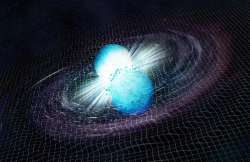LIGO, NASA research of neutron collision indicate birth of new black hole
It is being estimated that the gravitational waves detected last year may have led to the lowest mass black hole ever found, says the scientist who analysed data from NASA’s Chandra X-ray Observatory.

The Laser Interferometer Gravitational Wave Observatory (LIGO) and NASA's Fermi mission have found the source of gravitational waves emitted due to the merger of two neutron stars. The source officially known as GW170817 was detected last year.
It is also being estimated that the gravitational waves detected last year may have led to the lowest mass black hole ever found, says the scientist who analysed data from NASA’s Chandra X-ray Observatory. The X-rays from Chandra are critical for understanding what happened after the two neutron stars collided.
LIGO data astronomers have assessed the mass of object resulting from the neutron star merger to be about 2.7 times the mass of the sun. This puts it on a tightrope of identity, implying it is either the most massive neutron star ever found or the lowest mass black hole ever found. The previous discoveries of the lowest mass black hole were no less than four to five times the sun’s mass.
Dave Pooley of Trinity University in the US affirms to the knowledge of neutron stars and black holes having being read throughout under the Chandra telescope. "We have both data and theories on how we expect such objects to behave in X-rays.”
If the neutron stars merged and formed a heavier neutron star, then astronomers would expect it to spin rapidly and generate a very strong magnetic field. This, in turn, would have created an expanding bubble of high-energy particles that would result in bright X-ray emission.
But, the Chandra data show levels of X-rays that are a factor of a few to several hundred times lower than expected for a rapidly spinning, merged neutron star and the associated bubble of high-energy particles, implying a black hole likely formed instead. If confirmed, this result will show that a recipe for making a black hole can sometimes be complicated. In the case of GW170817, it would have required two supernova explosions that left behind two neutron stars in a sufficiently tight orbit for gravitational wave radiation to bring the neutron stars together.
"Astronomers have long suspected that neutron star mergers would form a black hole and produce bursts of radiation, but we lacked a strong case for it until now," said Pawan Kumar of the University of Texas at Austin in the US.
For a few days the Chandra telescope could not detect the source, but after a few subsequent observations, 15 16 days after the event detected the source. Though the source went out of sight, behind the sun after about 110 days a brightening was recorded, followed by a high-intensity X-ray.
If it is to be a black hole, then the source should emit brighter X-ray and radio wavelengths in about a couple of years when the bubble of high energy particles catches up with the decelerating shock wave, and also the astronomers expect it to continue to become fainter, for now, the researchers said, that the observed X-ray emission as being due entirely to the shock wave - akin to a sonic boom from a supersonic plane - from the merger smashing into surrounding gas. There is no sign of X-rays resulting from a neutron star.